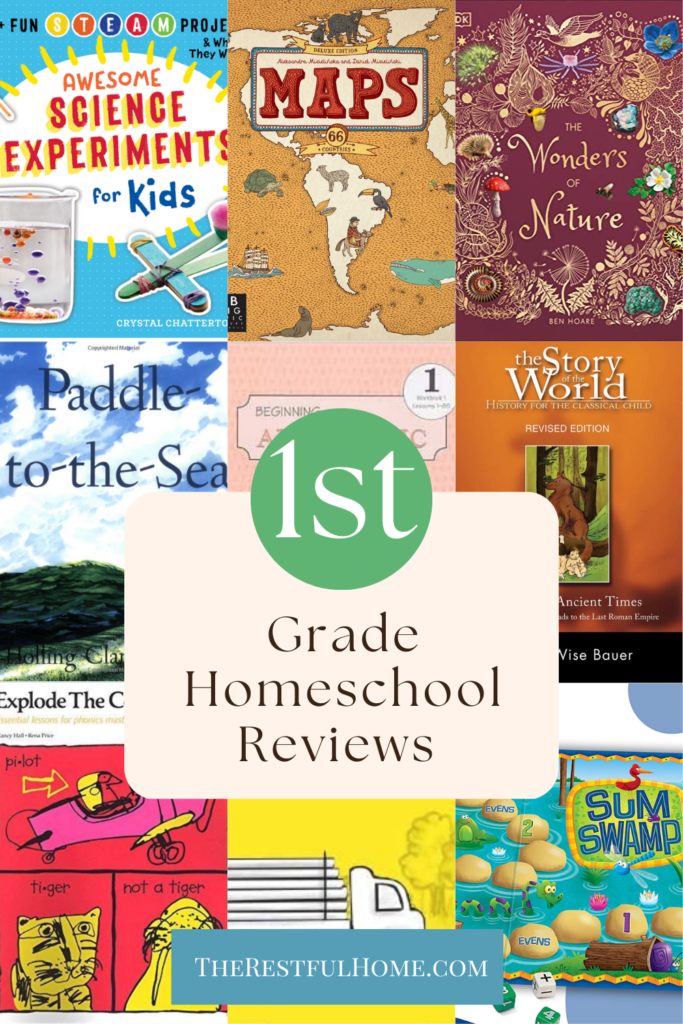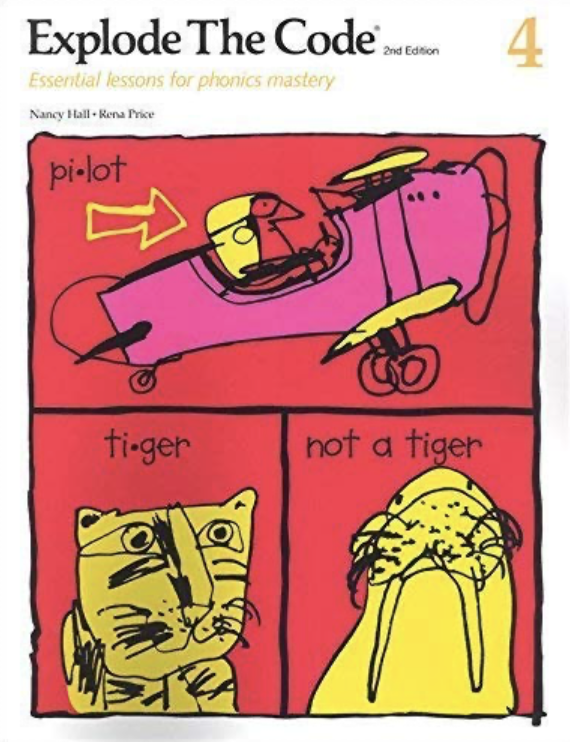I’m still in the midst of figuring out which curriculum selections are best for my little first grader, but I thought I’d take a moment to list some of the products we’ve used for our first grade homeschool. I’ll tell what we’ve loved and what we haven’t. I should also mention that we are using a Charlotte Mason-inspired approach to education. At the ages we currently have, I do a LOT of reading aloud with my children.
This list is not a YOU MUST USE ALL THESE BOOKS kind of list. Instead, it’s a collection of honest opinions about the books I have used in my eclectic homeschool.

First Grade Homeschool: Language Arts
During kindergarten, we started Handwriting without Tears. I liked the gentle, form-based approach to teaching handwriting. So I added the Printing Power workbook for his first grade practice.
We’ve chosen to wait on teaching cursive until he has solid printing skills.
Phonics
After Handwriting without Tears 1, we moved on to the Explode the Code series. Explode the Code is a fun way to join handwriting practice with phonics and reading practice. Halfway through first grade, my son completed Book 4. I like it because the repetitive, simple pictures are easy enough that he sees the work as fun and doesn’t need my help on every single page. I would recommend it to anyone who wants an enjoyable, child-friendly reinforcement to reading and writing phonetically. It is not a full language arts program, though, and it isn’t meant to be.
Some first grade programs start teaching composition. I have a young first grader, though, and he isn’t quite ready for that. Instead, I’m having him learn great writing by copying it. He has a lined workbook and most days, he copies a passage from great literature into his copybook. (From the Bible, poetry readings, our read-alouds, etc.–and he gets to help choose from several options.)
Poetry
Speaking of poetry, our favorite compilation is this one: The Golden Books Family Treasury of Poetry. The poetry is a mixture of simple with classic, and the illustrations are charming. We also love the National Geographic pairings of great photographs with animal/nature poetry. (They have a greater diversity among their selected authors than the old Golden Book anthology.) I try to read poetry to my kids about 4 times a week. I choose a poem and then each of them gets to choose one. (My preschooler tends to choose the same ones over and over.) Sometimes we check out an anthology from the library, as well. (Shel Silverstein is a favorite in our house.)
First Grade Homeschool: Math & Logic
Rod & Staff Math 1: Economical but Not Engaging
This year, I chose to buy the Rod & Staff first grade math book from Memoria Press. And…it’s ok. I chose it because it was economical and recommended by a friend. And it does a good job with drilling addition and subtraction facts. However, it’s really boring. I’ve tried to help it out by using dominoes as counters, pulling out the Math-U-See building blocks from my own childhood, etc. But it’s not a thrilling book for a young child. My son dreads the pages full of sums. We will not be using Rod and Staff for math again.
I’m not suggesting that Rod & Staff isn’t great for some children. But for a child with some attention issues who needs something that grabs his attention (like the fun pictures in Explode the Code), it is simply not the best choice. We had to take a break for a “math camp” with flash cards and games so he had more fun memorizing his addition facts.
We also used some of the Life of Fred stories because our library has them. They aren’t sufficient on their own for math practice, but they’re a much more engaging way to present math concepts. I like that algebra is gently presented very early in these books.
Games for Math and Logic
Something that has helped bribe-cough-encourage my son to complete his math each day is a game that I recommend wholeheartedly: Sum Swamp. We bought it last year and it’s been the most fun way to teach addition, subtraction, and the concept of even/odd numbers. Even my preschooler loves it, although we have to help her with the math.
For logic, we bought a couple of the logic-thinking Smart games from Timberdoodle. One was Cat & Mouse and the other was Three Little Piggies. The second was his favorite, but after some time his interest waned. He loves games right now, but only if they’re a group activity. Both of those games were single player.
First Grade Homeschool: Science
Science is the area that lights up my little boy’s life. We don’t have a formal science curriculum right now, because I’m hoping to ignite interest rather than create more busywork. We check out piles of science books and STEAM kits from our library, especially on space, which has been my little boy’s passion for the last few years. Once a week we go to the library, where I have books already on hold and where I let him select some of his own readers, picture books, and nonfiction concept books.
Some of my favorite things that we’ve bought for science:
- Awesome Science Experiments for Kids, by Crystal Chatterton. My goal was to do one of these experiments weekly, but honestly, that hasn’t always happened. Our Friday science days sometimes end up being zoo visits or other fun field trips. However, I love this book’s focus on using household items to demonstrate scientific knowledge.
- Various STEAM kits. We were given a couple of the KiwiCo crates, which were super fun for my hands-on learner. So then we started buying some of the STEAM kits at Costco. My husband did one with him on hydraulics and is now doing a flight concept kit with him. We also have ones on magnets and space. The library carries a good collection of STEAM kits, but waiting lines are long, so we’ve only been able to check out a few of them.
Botany:
We aim for a couple of days a week of “nature journaling.” I take them out into some tree-and-wildlife rich area (sometimes hard to find in the city!) and we pull out our Hobby Lobby sketchbooks to draw what we see. Sometimes they choose to draw ants and bugs; sometimes trees or grass. They’re learning to be more observant. And, guess what? So am I! I’ve grown to love drawing in my sketchbook, even though I don’t have a lot of artistic talent.
We are also reading through the beautiful DK book Wonders of Nature, which I highly recommend.
First Grade Homeschool: Geography & History
Again, our library is a major resource for us in every subject! I love being able to check out picture books about the Assyrians or the country of Brazil without having to buy them or store them indefinitely on my shelves.
History
I’m reading aloud the Story of the World: Volume I, by Susan Wise Bauer. I think she does an amazing job of presenting history in an engaging way, by including ancient folk tales and telling stories about children who may have lived in ancient times. She also tells about Asian history, which I really appreciate. Often history books can be veryEurocentric.
The cons of Story of the World? Mostly I just dislike the lack of pictures. The book is very inexpensive because of the lack of colorful pictures, but they would help so much with engaging a child’s attention. To make up for this flaw, I look ahead at what we will be studying and place holds on library books that will fill in the gaps. (For example, if we are studying ancient China, I’ll check out picture books about the terra cotta soldiers, the Great Wall, the Yellow River, and various emperors.) I also find videos on YouTube as we go along (like about the process of making silk from silkworms). And sometimes we do crafts, draw pictures, or run to the map on the wall to point out the area we are studying.
Geography
For American geography, I am reading aloud classics from my own childhood: Holling C. Holling’s series of beautiful books. First, we read through Paddle to the Sea. It’s the story of a little canoe who travels all the way through the Great Lakes to the ocean. We followed that book with Seabird.
A favorite among the books I’ve bought for geography is Maps: Deluxe Edition. It’s so much fun to study the tiny pictures on each country’s map. Not every country has been drawn yet, but it will take us quite some time to study each one presented. The authors are Polish, which explains why so many more of the Eastern European countries are here than south or Central American countries. 🙂 My mom also bought my kids the Mizielinskis’ Under Water, Under Earth, which is equally stunning.
Read Alouds
Because of the weekly library visit, I have read aloud what must have been an entire mountain of picture books. But I’ve also read aloud a few longer books that took months to read. I’ve written a separate post on the longer books we’ve enjoyed during my son’s first grade year. (Click on the link or on the image below.)
J’s favorite books to read aloud to me are the Billy and Blaze series (a sweet older series about a boy and his pony) the Frog and Toad stories by Arnold Lobel, and the Little Bear books by Elsie Minarik. I also recommend the readers based on David Macaulay’s amazing nonfiction books.
More fun books for emerging readers: Cynthia Rylant’s Mr. Putter & Tabby series, Rebecca Bond’s Pig and Goose and the First Day of Spring, Avi’s Prairie School and Abigail Takes the Wheel, and the Mr. & Mrs. Green books by Keith Baker. The Boxcar Children has simple, engaging text and a storyline that has made children of several generations fall in love with the kids who move into a boxcar. My first grader was really proud when he was able to read a “big book,” and we made a big deal out of his finishing The Boxcar Children.
Bible
We have a daily Bible story time and memorization first thing after breakfast. Right now we are working our way through Kevin DeYoung’s The Biggest Story Bible Storybook, which is worth buying for the art alone! Some of the informal wording wouldn’t be my first choice for a Bible storybook. But I like the way the stories point to Christ, and I’ve been really moved by his retelling of some of the prophetic books that are usually skipped in children’s Bible storybooks.
First Grade Homeschool Art/Music
I count nature journaling as both science and art. We’ve also made several trips to local museums, sculpted creations with modeling clay and MadMattr (which is really fun for little ones–like a cross between kinetic sand and PlayDoh). I check out oversized art books from the library and we do “picture studies” in which we talk about what the artist has portrayed in a particular work and the techniques he may have used.
We have a ukulele, 1/4 sized violin, and keyboard readily available. I haven’t used any resources for teaching any of these instruments that I can review yet.
And that’s a wrap!
I hope this informal review of our first grade homeschool material is helpful for fellow home educators. Any comments you share via the comment section, social media, or email are welcome: I enjoy hearing recommendations from others!

